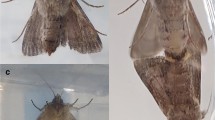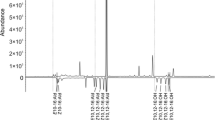Abstract
The diel periodicity of sex pheromone release was monitored in two mealybug species, Planococcus citri and Planococcus ficus (Hemiptera; Pseudococcidae), using sequential SPME/GCMS analysis. A maximal release of 2 ng/h pheromone by 9–12-day-old P. citri females occurred 1–2 h before the beginning of photophase. The highest release of pheromone by P. ficus females was 1–2 ng/2 h of 10–20-day-old females, approximately 2 h after the beginning of photophase. Mating resulted in termination of the pheromone release in both mealybug species. The temporal flight activity of the males was monitored in rearing chambers using pheromone baited delta traps. Males of both P. citri and P. ficus displayed the same flight pattern and began flying at 06:00 hours when the light was turned on, reaching a peak during the first and second hour of the photophase. Our results suggest that other biparental mealybug species display also diel periodicities of maximal pheromone release and response. Direct evaluation of the diel periodicity of the pheromone release by the automatic sequential analysis is convenient and will be very helpful in optimizing the airborne collection and identification of other unknown mealybug pheromones and to study the calling behavior of females. Considering this behavior pattern may help to develop more effective pheromone-based management strategies against mealybugs.





Similar content being viewed by others
References
Bartelt RJ (1997) Calibration of a commercial solid-phase microextraction device for measuring headspace concentrations of organic volatiles. Anal Chem 69:364–372
Bierl-Leonhardt BA, Moreno DS, Schwartz M, Forster HS, Plimmer JR, De Vilbiss ED (1982) Isolation, identification, synthesis and bioassay of the pheromone of the Comstock mealybug and some analogs. J Chem Ecol 8:689–699
Bostanian NJ, Vincent C, Rufus I (2012) Arthropod management in vineyards: pests, approaches, and future directions. Springer–Verlag, New York, 505 p
Byers JA (2006) Pheromone component patterns of moth evolution revealed by computer analysis of the Pherolist. J Anim Ecol 75:399–407
Charlton RE, Cardé RT (1982) Rate and diel periodicity of pheromone emission from female gypsy moths, (Lymantria dispar) determined with a glass-adsorption collection system. J Insect Physiol 28:423–430
Daane KM, Bentley WJ, Millar JG, Walton VM, Cooper ML, Biscay P, Yokota GY (2008) Integrated management of mealybugs in California vineyards. Acta Horticult 785:235–252
De Alfonso I, Hernandez E, Velazquez Y, Navarro I, Primo J (2012) Identification of the sex pheromone of the mealybug Dysmicoccus grassii Leonardi. J Agric Food Chem 60:11959–11964
Franco CJ, Suma P, Zada A, Mendel Z (2004) Comparative biology of the citrus mealybug and the vineyard mealybug (Hemiptera: Pseudococcidae). X International Symposium on Scale Insect Studies – ISSIS. Adana, Turkey. 19–23 April
Franco JC, Silva EB, Cortegano E, Campos L, Branco M, Zada A, Mendel Z (2008) Kairomonal response of the parasitoid Anagyrus spec nov. near pseudococci to the sex pheromone of the vine mealybug. Entomol Exp Appl 126:122–130
Franco JC, Zada A, Mendel Z (2009) Novel approaches for the management of mealybug pests. In: Ishaaya I, Horowitz AR (eds) Biorational control: application and resistance managements. Springer, Netherland, pp 233–278
Franco JC, Silva EB, Fortuna T, Cortegano E, Branco M, Suma P, La Torre I, Russo A, Elyahu M, Protasov P, Levi-Zada A, Mendel Z (2011) Vine mealybug sex pheromone increases citrus mealybug parasitism by Anagyrus sp. near pseudococci (Girault). Biol Control 58:230–238
Hardy NB, Gullan PJ, Hodgson CJ (2008) A subfamily-level classification of mealybugs (Hemiptera: Pseudococcidae) based on integrated molecular and morphological data. Syst Entomol 33:51–71
Levi-Zada A, Nestel D, Fefer D, Nemni-Lavy E, Deloya-Kahane I, David M (2012) Analyzing diurnal and age-related pheromone emission of the olive fruit fly, Bactrocera oleae (Diptera: Tephritidae) by sequential SPME-GCMS analysis. J Chem Ecol 38:1036–1041
Levi-Zada A, Sadowsky A, Dobrinin S, David M, Ticuchinski T, Fefer D, Greenberg A, Blumberg D (2013) Reevaluation of the sex pheromone of the lesser date moth, Batrachedra amydraula, using autosampling SPME-GC/MS and field bioassays. Chemoecology 23:13–20
Levi-Zada A, David M, Fefer D, Seplyarsky V, Sadowsky A, Dobrinin S, Ticuchinski T, Harari D, Blumberg D, Dunkelblum E (2014) Circadian release of male-specific components of the Greater Date Moth, Aphomia (Arenipses) sabella, using sequential SPME/GC–MS analysis. J Chem Ecol 40:236–243
Mendel Z, Dunkelblum E, Robinson D (1990) Sexual behavior of Matsucoccus josephi (Homoptera: Margarodidae) asynchronous adult male emergence and release of female sex pheromone. J Chem Ecol 16:2341–2352
Mendel Z, Protasov A, Jasrotia P, Silva EB, Zada A, Franco JC (2012a) Sexual maturation and aging of adult male mealybugs. Bull Entomol Res 102:385–394
Mendel Z, Jasrotia P, Protasov A, Kol-Maimon H, Levi-Zada A, Franco JC (2012b) Responses of second-instar male nymphs of four mealybug species (Hemiptera: Pseudococcidae) to conspecific and heterospecific female sex pheromones. J Insect Behav 25:504–513
Millar JG, Daane KM, Mcelfresh S, Morriera JA, Guillen M (2002) Development and optimization of methods for using sex pheromones for monitoring the mealybug Planococcus ficus (Homoptera: Pseudococcidae) in California Vineyards. J Econ Entomol 95:706–714
Moreno DS, Fargerlund J, Ewart WH (1984) Citrus mealybug (Homoptera: Pseudococcidae): behaviour of males in response to sex pheromone in laboratory and field. Ann Entomol Soc Am 77:32–38
Park SC, Abrahamson LP (1991) Daily rhythm of pheromone production and release by females of the black pine bast scale Matsucoccus thunbergianae Homoptera: Coccoidea: Margarodidae. Korean J Appl Entomol 30:94–99
Phelan PL (1997) Evolution of mate signaling in moths: phylogenetic considerations and predictions from the asymmetric tracking hypothesis. In: Choe JC, Crespi BJ (eds) Mating systems in insects and arachnids. Cambridge University Press, Cambridge, pp 240–256
Rotundo G, Tremblay E (1976) Osservazioni sull attivitadi volo dei maschi di Pseudococcus calceolariae (Mask.) (Homoptera: Coccoidea). Boll Lab Entomol Agric F Silvestri Portici 33:108–112, in Italian
Rotundo G, Tremblay E (1980) Evaluation of the daily rate of sex pheromone release by the females of two mealybugs species (Homoptera Coccoidea Pseudococcidae). Boll Lab Entomol Agric F Silvestri Portici 37:167–170
Silva EB, Mouco J, Antunes R, Mendel Z, Franco JC (2009) Mate location and sexual maturity of adult male mealybugs: narrow window of opportunity in a short lifetime. IOBC WRPS Bull 41:3–9
Silva EB, Branco M, Mendel Z, Franco JC (2013) Mating behavior and performance in the two cosmopolitan mealybug species Planococcus citri and Pseudococcus calceolariae (Hemiptera: Pseudococcidae). J Insect Behav 26:304–320
Snir R, Dunkelblum E, Gothilf S, Harpaz I (1986) Sexual behavior and pheromone titre in the tomato looper, Plusia chalcites. (ESP) (Lepidoptera: Noctuidae). J Insect Physiol 32:735–739
Sugie H, Teshiba M, Narai Y, Tsutsumu T, Sawamura N, Tabata J, Hiradate S (2008) Identification of a sex pheromone component of the Japanese mealybug, Planococcus kraunhiae. Appl Entomol Zool 43:369–375
Tabata J, Narai Y, Sawamura N, Hiradate S, Sugie H (2012) A new class of mealybug pheromones: a hemiterpene ester in the sex pheromone of Crisicoccus matsumotoi. Naturwissenschaften 99:567–574
Walton VM, Pringle KL (2004) Vine mealybug, Planococcus ficus (Signoret) (Hemiptera: Pseudococcidae), a key pest in South African vineyards. S Afr J Enol Vitic 25:54–62
Walton VM, Daane KM, Walter J, Bentley WJ, Millar JG, Larsen TE, Malaker-Kuenen R (2006) Pheromone-based mating disruption of Planococcus ficus (Homoptera: Pseudococcidae) in California vineyards. J Econ Entomol 99:1280–1290
Williams DJ (1985) Australian mealybugs. British Museum of Natural History, London, UK, London, p 431
Zada A, Dunkelblum E, Assael F, Harel M, Cojocaru M, Mendel Z (2003) Sex pheromone of the vine mealybug, Planococcus ficus in israel: occurrence of a second component in a mass-reared population. J Chem Ecol 29:977–988
Zada A, Dunkelblum E, Harel M, Assael F, Gross S, Mendel Z (2004) Sex pheromone of the citrus mealybug Planococcus citri: synthesis and optimization of trap parameters. J Econ Entomol 97:361–368
Zada A, Dunkelblum E, Assael F, Franco JC, Silva EB, Protasov A, Mendel Z (2008) Attraction of Planococcus ficus males to racemic and chiral pheromone baits: flight activity and bait longevity. J Appl Entomol 132:480–489
Acknowledgments
We thank Omer Golan, KKL-JNF Forestry Department, for technical help and Eyal Erel of BIOBEE for supplying the P. citri colonies.
Author information
Authors and Affiliations
Corresponding author
Additional information
Communicated by: Sven Thatje
Electronic supplementary material
Below is the link to the electronic supplementary material.
ESM 1
(DOCX 191 kb)
Rights and permissions
About this article
Cite this article
Levi-Zada, A., Fefer, D., David, M. et al. Diel periodicity of pheromone release by females of Planococcus citri and Planococcus ficus and the temporal flight activity of their conspecific males. Naturwissenschaften 101, 671–678 (2014). https://doi.org/10.1007/s00114-014-1206-y
Received:
Revised:
Accepted:
Published:
Issue Date:
DOI: https://doi.org/10.1007/s00114-014-1206-y




